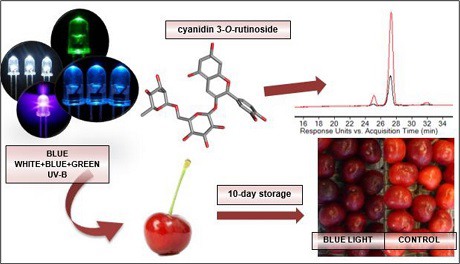A study from the University of Ljubljana (Slovenia) showed how light wavelengths can influence the quality of cherries in cold storage. Irradiation with blue light increased anthocyanin content, while blue and white-blue-green light increased phennylaline ammonia lyase (PAL) activity. Researchers have in fact found a high correlation between PAL and anthocyanins.

"Light can influence the post-harvest formation of bioactive compounds in fruit and vegetables. The objectives of this study were to determine the physico-chemical changes and PAL and flavonoid 3'-hydroxylase activities in cherries irradiated with light-emitting diodes."
Cherries were stored under UV-B and blue light and under a combination of white, blue and green light for ten days.
"Irradiation with blue light significantly increased the cyanidin 3-O-glucoside and cyanidin 3-O rutinoside content and significantly influenced the color parameters of the fruit. The combined white-blye-green light produced similar yet less pronounced effects, while UV-B light produced similar effects to control (in the dark)."
"Irradiation had no significant effects on abscorbic acid and phenolic profile. Highly-significant correlations were bound between anthocyans and PAL on the one side and with fruit color on the other."
Source: Doris Kokalj, Emil Zlatić, Blaž Cigić, Rajko Vidrih, 'Postharvest light-emitting diode irradiation of sweet cherries (Prunus avium L.) promotes accumulation of anthocyanins', 2019, Postharvest Biology and Technology, Vol. 148, pag. 192-199.










